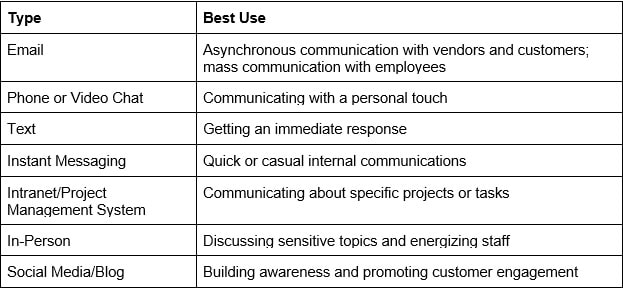
7 Tips and Tricks for Effective Communication in the Business World
7 TIPS AND TRICKS FOR EFFECTIVE COMMUNICATION IN THE BUSINESS WORLD
You’ve started a business. You’ve got a good product, built your operation, and started making good sales. But, you have challenges. You have a good team, but have trouble keeping people on the same page or taking advantage of the momentum you’ve worked so hard in your business.
So, what’s going wrong?
Chances are, it’s communication. Every business leader has a vision for their company. The good ones are able to get their business started through sheer force of will. But, there comes a time when a business needs to be propelled forward by its own momentum.
Effective communication—with your managers, your employees, your vendors, and your customers—is how you make that happen.
To help you communicate within and about your business, we compiled a list of the seven most effective business communication tools and tips for how to use them best.
Top 7 Forms of Business Communication

Obviously, not all businesses use all these forms of communication, and some use still other options. But, of the big seven named above, it’s important to know when each one is best and how to use each one to effectively communicate complex ideas both inside and outside your company.
1. Email
Despite the growth of instant messaging and other options, email remains the most common type of business communication. With over 120 billion business emails sent every day, this medium is a great way to convey information in a controlled manner.
Using email, you can review communications before you send them to make sure they focus on the right things and convey the correct tone. You can also make sure that any demands or requests that you’re passing to the recipient come across clearly and with the proper sense of urgency.
Email is best when you’re trying to convey complex ideas or want to present a professional face to outsiders.
Email is also ideal for asynchronous communication; when you don’t need an answer right away, but can let the recipient gather their thoughts before responding.
Lastly, email is the best option when you want to document interactions—when you’re seeking approval for a project, clarifying discrepancies, or making sure that everyone is on the same page. None of these are things that can be done effectively over the phone.
Tips & Tricks
- Compose a professional email signature that includes your name, direct contact information, and include any necessary disclosures
- Re-read messages before sending
- Make the purpose of your email clear upfront
- Make clear any requests of recipients
When to Avoid
While email works great in many situations, it’s not always the best choice.
For example, if you need an immediate answer to an urgent question, then you might be better served using instant messaging, phone, or text. One of these might also be more beneficial when your communication needs a more personal touch.
Similarly, if you’re trying to convey a lot of information about a product or service to customers, email may not be as effective as a whitepaper or newsletter.
2. Phone and Video Chat
Physically talking via phone or web conference isn’t a written form of communication (except if you’re using a script or reading a prepared statement), but it nevertheless has big advantages in certain situations.
The biggest benefit of phone or video chat is the personal touch that helps you relate to recipients.
When you speak with someone by phone or on video, they get to hear your voice and participate in real-time dialogue, which helps to establish a personal connection and improve the free flow of information.
This makes communicating by phone a great option when you’re trying to establish a connection with someone, soften the blow of bad news, or communicate a message that is dependent on feedback or insight to be gleaned from the recipient.
If you want to maximize the impact of your message or deepen your connection, video chat is far better than phone. However, it only works if both you and the recipient have reliable internet. Any technical difficulties can have the opposite effect.
Tips & Tricks
- Know what hours are good for the person you’re contacting
- Always call from a recognized number
- Don’t try to multitask—give the call your full attention
- Call from a calm, quiet place to avoid background noise or interruptions
When to Avoid
Using the phone for business can be a great option when you want a more personal touch or need some back-and-forth in your communication with a recipient, but it isn’t always ideal.
When you need to measure your words and communicate carefully, the phone is usually a terrible option.
Also, when you’re sending or receiving communications that you want to document for the future, it can be difficult to do so over the phone.
So, if you’re worried about a misunderstanding later, want to avoid back-and-forth, or are worried that you may go off script, you should probably consider another form of communication.
3. Text
Texting is also a good option when you need a quick answer to a question or want to quickly convey small bits of information. However, texting is generally a little less personal than a phone call and doesn’t offer the sender a good opportunity to convey lots of information.
It’s also important to remember that not everyone texts—especially for business.
And, texting requires you to be extra careful with the tone of your message, as it’s very easy for messages to be taken too casually or for the recipient to misunderstand what you’re trying to say.
Tips & Tricks
- Avoid flowery language or unnecessarily long texts (no treatises)
- Know whether the recipient texts
- Avoid emojis unless you have an established rapport with the recipient
When to Avoid
Texting can be a good option for conveying quick points or getting answers fast, but it’s definitely NOT the way to go when you have a lot of information to convey.
It’s also best to avoid texting completely if you don’t know that the recipient texts or if you need to convey a lot of information.
4. Instant Messaging
Instant messaging is a form of business communication that’s grown tremendously in popularity, especially with the advent of platforms like Slack, Skype, or even Google Hangouts.
In this context, it’s best used for checking in with individual employees, keeping track of group projects, or making occasional company announcements.
Instant messaging is great because it keeps messages from getting lost in email inboxes, which tend to fill up quickly. It also helps business owners and managers avoid having to constantly text or call employees for small things.
However, it’s important to remember that this form of communication works best during hours when recipients are typically online.
Tips & Tricks
- Don’t encourage excessive use to “build company culture,” as communication can become too casual and cease to be professional
- Don’t make too many announcements—people will end up focusing on their messages instead of their work
- Avoid gossip or jokes that not all employees will appreciate (stick to PG-13)
When to Avoid
Instant messaging is great for quick, internal, task-related business communications, but if you have serious messages or a lot of information to convey, it’s not usually the best option.
If you need to have a one-on-one dialogue with an employee about a serious issue (such as their employment), then the personal touch of a phone call is probably better.
Or, if you need something outside normal business hours, then you shouldn’t depend on instant messaging.
5. Intranet & Project Management Systems
With the advent of video chat and instant messaging platforms like Slack, company intranets aren’t as popular as they once were.
But, many companies still use project management systems like Wrike, Asana, Trello, and Insightly, and most of these offer chat or comment boxes that give employees the ability to exchange messages.
While these systems can work well for discussing projects back and forth, they usually aren’t great for communication that needs quick responses, because many don’t include live chat features that employees can monitor constantly.
In fact, the only communication tools that many of these systems offer is a commenting feature that’s usually tied to individual projects; so communication done over these platforms usually needs to be related to specific tasks or projects that a team is working on.
Tips & Tricks
- Stick to discussions about specific projects or tasks
- Encourage employees to share plenty of context in their messages
- Actively discourage rude or abrupt messages
When to Avoid
- If a project needs input from multiple people simultaneously
- If a project is apt to change direction suddenly
6. In-Person Meetings
In the modern age, in-person meetings are becoming increasingly rare, but that makes them all the more valuable as opportunities for business leaders to deepen personal connections and energize their team.
While in-person meetings can be extremely useful for managers who want to leverage their personal connections to employees, create a safe space for the sharing of ideas, or deepen the impact of their message, this method is also much riskier than other forms of communication.
For one thing, you can’t review what you’re going to say before you say it.
If you misspeak or fail to clearly communicate something to an employee, client, or partner, confusion can result.
And if you say something unfeelingly in the moment, you can engender animus that lasts a lifetime.
Still, when it comes to communicating in business, in-person meetings are as personal as it gets. If you need to discuss a delicate matter or maximize your team’s combined brainpower to accomplish a task, a face-to-face meeting may be the only way to go.
Tips & Tricks
- Be an active listener; don’t monopolize the conversation
- Give the meeting your full and undivided attention
- Don’t schedule meetings to close together, so people can collect their thoughts before and afterward
When to Avoid
- When you need to measure your words
- If you need to communicate about sensitive issues with potential legal ramifications
- If you or your colleagues aren’t able to be good listeners and stay engaged in the task at hand
7. Social Media/Blog
This form of communication can take place over platforms such as Facebook, Instagram, Linkedin, and others.
It can take the form of posts on one or more of these platforms or direct messages with individual customers (or potential customers) through company social media accounts.
Direct messages can be exchanged using tools like Facebook Messenger, Instagram, Twitter, and others.
Communications can also include those conducted through live chat features on company websites.
Regardless of platform, these types of communication are ideal for interacting with customers or prospective customers to develop awareness, build goodwill, or answer specific questions about your business or your offerings.
Using social media, you can also build an awareness of your brand, encourage interactions with your followers, and showcase your corporate social responsibility through involvement in your community or various social causes.
Tips & Tricks
- Commit the time and resources to keep up with your social media presence
- Respond to all direct messages within 12 to 24 hours
- Review all posts before publishing as well as individual messages prior to sending
- Keep business profiles separate from personal
- Avoid debates, disagreements, and controversies, even and especially with individual customers
When to Avoid
Using social media for business communications can be a great way to build a following, communicate with customers in a casual online setting, and share—succinctly—the benefits of your company or its offerings.
However, it’s generally not the best option when you have specific information to share with an individual person.
Social media is also usually not a good idea if you can’t commit to keeping up with it, as it requires consistent posting and interaction with your audience.
Wrapping Up
Today, more than ever before in history, effective communication in business is of the utmost importance.
Whether it’s keeping your employees productive and working toward common goals, or conveying important information to your customers, effective communication requires using the right form of communication in the right way.
If you’re struggling to decide which methods are best for your business needs, be sure to consider the tips and tricks above to help establish best practices for your business communication.
Related Content
- 0 Comment
Subscribe to Newsletter
- How Can SharePoint Be Used To Organize and Disseminate SOPs?
- Planning the Perfect Genealogy Research Trip: A Step-by-Step Guide
- From Silly to Awesome: How Words Change Meaning Over Time
- The Psychology of Font Choice: How Typography Impacts Content Engagement
- How to Distribute SOPs for Maximum Usability




